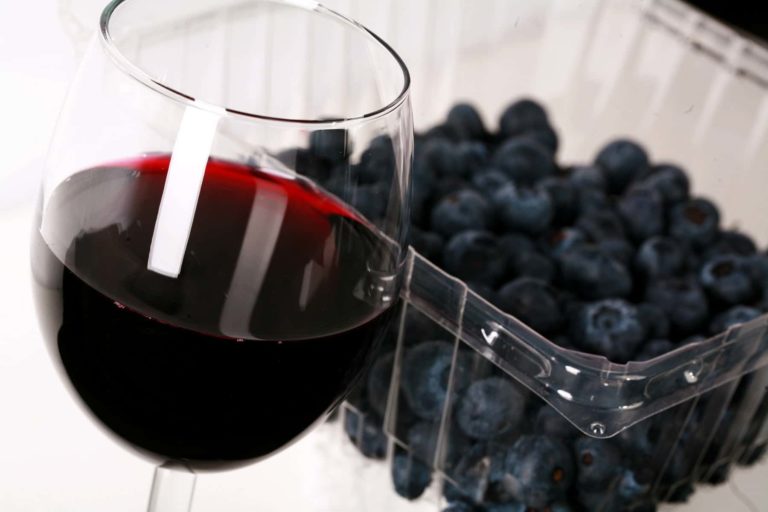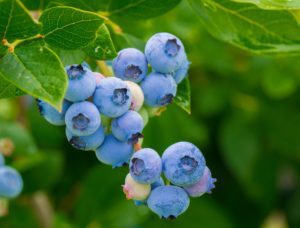
Blueberry Wine Recipe – The recipe is a good place to begin if you are new to the game of winemaking. This blueberry wine recipe is the perfect amalgamation of sweet and tart. The natural flavour of the fresh blueberries gives the wine a deeper and more intense flavour. You can expect a flavorful, full-bodied wine by the time it is ready to be bottled.
Contents
What Kind Of Fruit To Pick For The Wine?
Contrary to popular belief that fresh fruit is the good one when it comes to making wine, this recipe comes out much better if you use frozen berries. There are two main reasons for that:
- Fruit that is picked for being frozen is usually larger and a lot riper than fruit that is picked to be sold in the supermarket. You can therefore expect a sweeter and riper fruit if you use frozen produce.
- Freezing breaks down the juices and acids present in the fruits hence sweetening them to a greater extent.
- It makes sense to buy frozen berries as you will need a lot of them and the frozen ones are cheaper than the fresh ones.
Equipment Needed for Blueberry Wine Recipe

Since winemaking is a long and tedious process there is certain equipment you will need to get that perfect glass of heady liquid at the end of it.
- A large bucket to ferment the berries
- A nylon bag to strain the berries
- 1-gallon demijohn
- Bung and airlock
- A masher to smash the fruit
- Hydrometer
- Syphon
- Glass bottles for storage
Ingredients to make Blueberry Wine Recipe
Here is the list of the ingredients to make the amazing Blueberry Wine Recipe –
- 1.4 kg blueberries (frozen or raw)
- 1 kg sugar
- 4.2 liters water
- 2 tsp citric acid
- ⅛ tsp tannin
- 1 tsp yeast nutrient
- ½ tsp pectin enzyme
- 1 campden tablet
- 1 sachet wine yeast
Method of Preparation for Blueberry Wine Recipe

- Put the water into a large saucepan and once it is almost boiling, add the sugar. Stir continuously till all the sugar is dissolved completely. You will also need to sift any impurities that come along with the sugar.
- Put the blueberries into a bucket. Use the masher to smash all the berries. The berries do not need to be pureed, but they must all be smashed so that the juice is all released. Transfer the berries into a straining bag. This will ensure all the juice keeps dripping into the bucket while the seeds are separated.
- Now all the sugar and water solution to the berries. Pour in the remaining part of the water over the hot water and berry mixture. This will cool down the berry mixture as well.
- Mix in the citric acid, wine nutrient, and tannin. Mix it in thoroughly so that it combines with all the berry juice. Leave this mixture to cool for a few hours.
- Add 1 tablet of campden and leave the mixture for another 12 hours.
- Once the 12 hour period is over add the peptic enzyme. Again leave for 24 hours. Now test with a hydrometer to see if you can begin the fermentation process.
- If the 24 hours have passed, add the yeast. Wait for a week at least so that the berries have a chance to ferment well. If the fruit ferments well, the juices will develop well, giving the wine a deeper flavor. You can stir the liquid once every two days.
- After a week, remove the straining bag from the bucket. Allow the bag to hang for a few days so that the maximum amount of juice can be extracted. Do not squeeze the bag as this might lead to extraction of the seeds as well and the wine will get muddy.
- At this stage, use your hydrometer to check the specific gravity of the liquid. If the specific gravity is below 1.010 the wine is ready to be decanted.
- It will take another 2 months for the Blueberry Wine Recipe to sediment. Once you notice most of the sediments settling down, you can transfer the wine to another vessel.
- Keep it for a few more days to check for any more sediments. If there are none, you can begin to bottle the wine.
- Now you can begin consumption immediately or store it for a few months more to let it mature.
Concluding Thoughts
Winemaking is an art and it might take a few attempts for you to be able to make the perfect brew. The flavor will keep deepening as the wine matures, so store appropriately. And that’s a wrap on our overview of winemaking. We hope you found this information educational and informative. If you have any questions or feedback, please don’t hesitate to reach out. Cheers to your winemaking journey and enjoy your handcrafted wine!